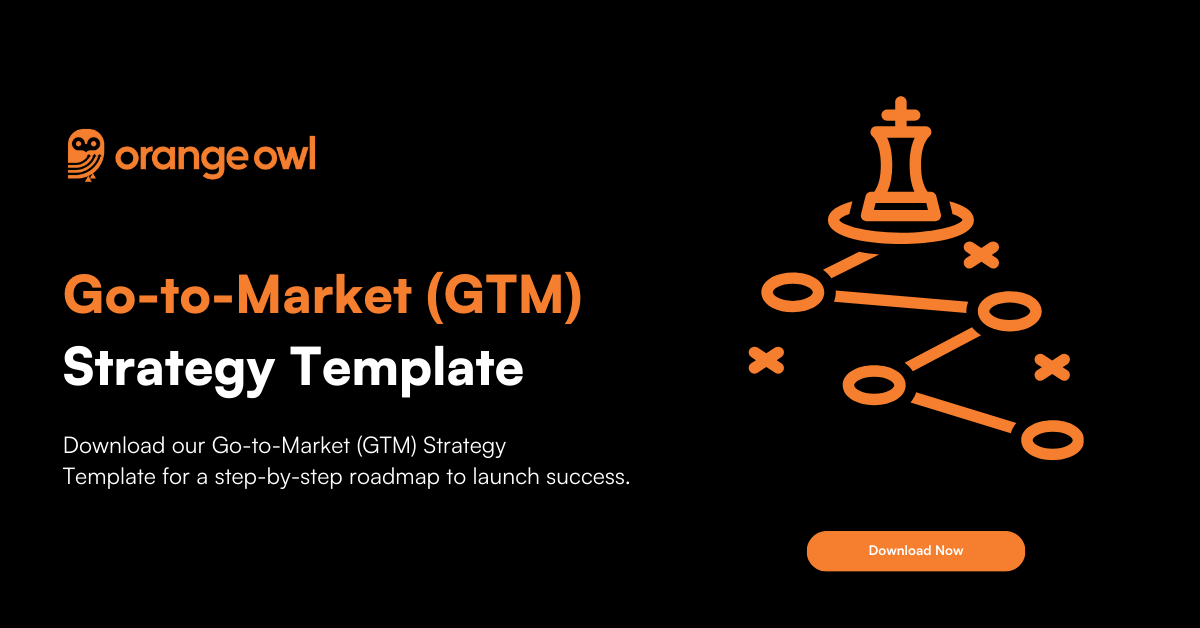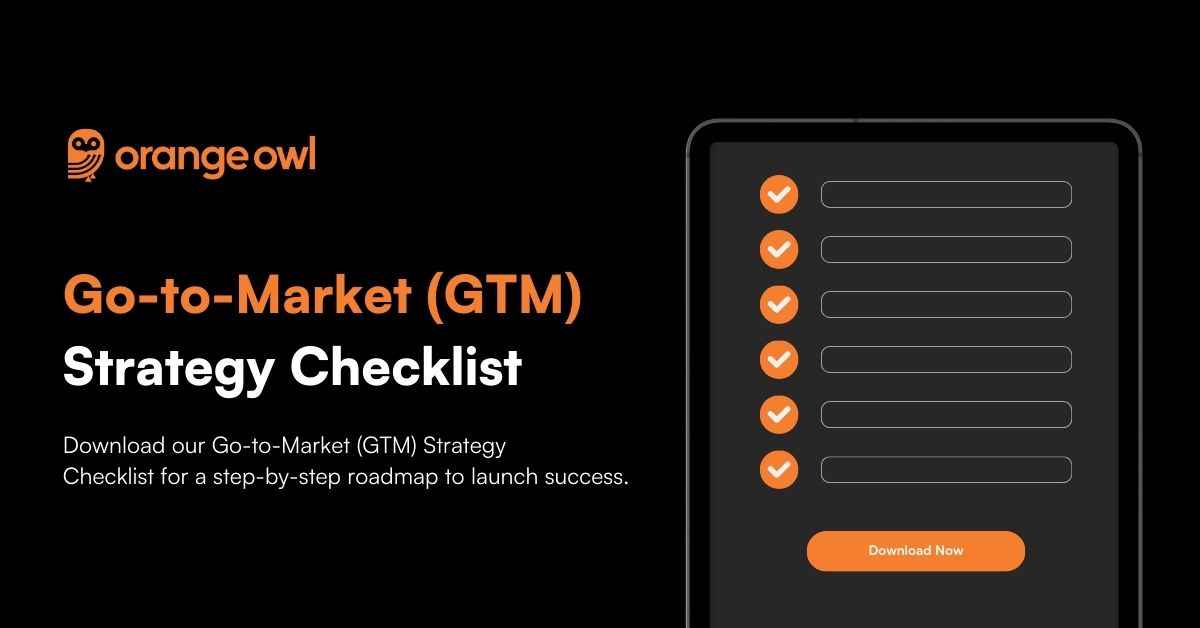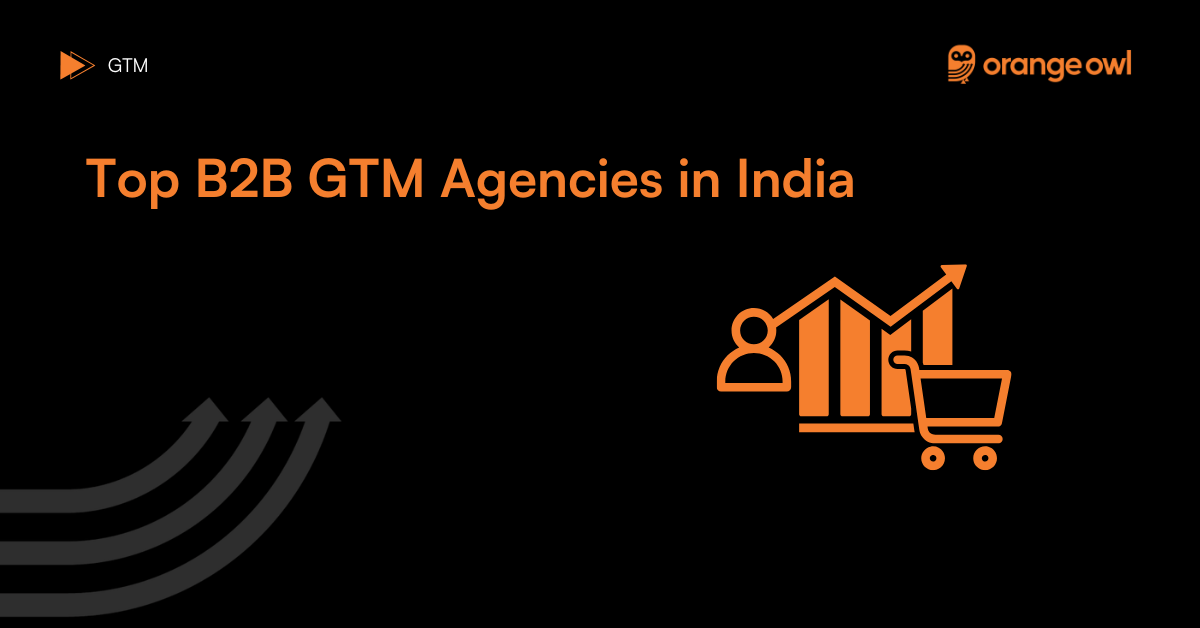Complete Guide to Crafting a Comprehensive Go-To-Market Strategy for B2B Companies
Vivek Goel
July 28, 2025
Approximately 20% of new businesses or startups fail during their first two years and 45% during their first five years. What is even more shocking is the fact that these numbers have been fairly consistent since the 1990s.
[source]
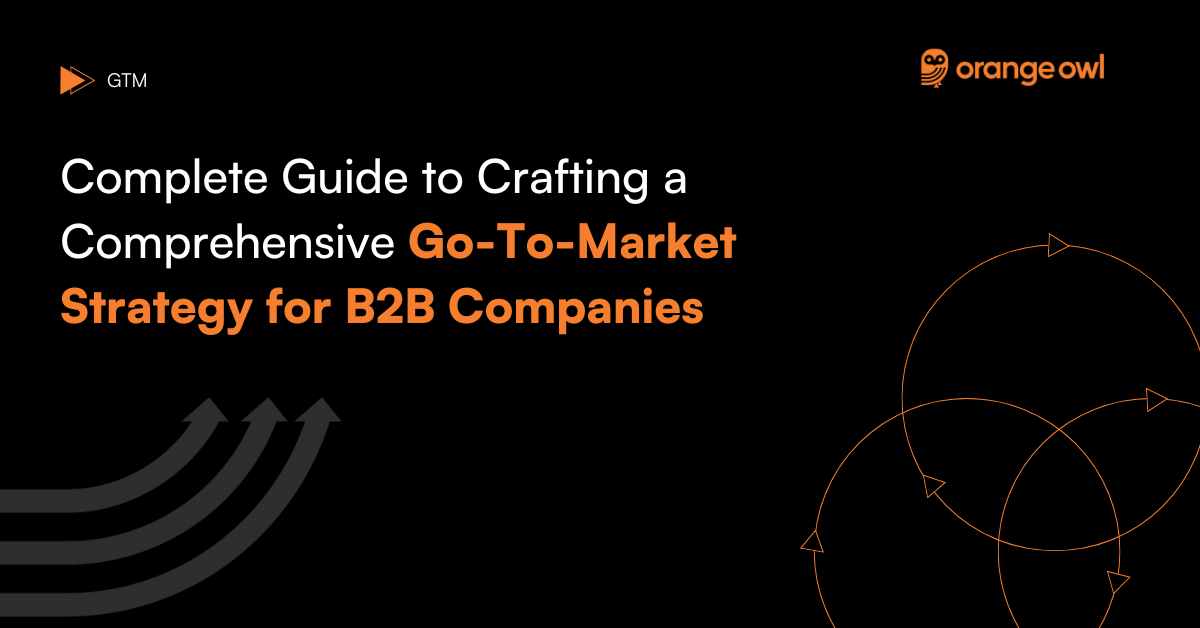
Table of Contents
Now whether you’re launching a new business or are simply expanding your product portfolio, you can avoid failure with the help of a go-to-market strategy. Developing this strategy will guide you every step of the way—from preparing your product to launching it and assessing its performance.
If you don’t want to be counted in that 20% or 45% of businesses that fail, stay with us as we explore go-to-market strategy. In this GTM guide, we’ll cover the meaning and benefits of GTM and see how you can create a go-to-market strategy for your business. Moreover, we also have a GTM planning checklist that you can download for your reference.
What is a go-to-market strategy?
A go-to-market (GTM) strategy is your action plan for launching a product or service into the market, targeting specific customer segments and channels to gain a competitive edge. It outlines your product’s value proposition, marketing and sales tactics, and how to engage with your intended audience.
Think of GTM as the roadmap for how you’ll introduce your offerings to the market, aiming to reach the right customers, through the right channels, with the right message. By executing a well-thought-out GTM strategy, you can efficiently use your resources, attract your ideal customers, and achieve your sales targets more effectively.
Explore 5Ws and 1H for Crafting Effective B2B GTM Plans here.
What are the different types of GTM strategies?
There’s no one-size-fits-all solution when it comes to GTM strategies. However, there are types of GTM strategies that you should know about. According to your product and target audience, you can experiment with these types:
- Product-led: Centers on using the product itself as the main driver of customer acquisition, conversion, and expansion. It prioritizes product experience, offering immediate value to users, and encouraging organic growth through user satisfaction and word-of-mouth.
- Sales-led: Focuses on direct sales efforts to drive customer acquisition and growth. It relies heavily on a sales team to engage potential clients through personalized interactions, demonstrations, and negotiations, targeting larger deals or enterprise-level customers.
- Marketing-Led: Relies on broad-reaching marketing campaigns to build brand awareness and generate leads. This strategy includes multi-channel campaigns, content marketing, and storytelling to educate and attract potential customers at scale, positioning the brand as an industry thought leader. Marketing-led growth is effective for businesses aiming to establish a strong market presence and continuously fill the top of the sales funnel.
Demand generation: Focuses on creating awareness and demand for a product or service across a broad audience. It employs targeted marketing programs to nurture interest over time, building a pipeline of qualified leads for the sales team.
Inbound: Attracts customers through content creation, SEO, and social media marketing. By offering valuable information and solutions, it draws potential customers in naturally, converting them into leads and sales through a nurturing process based on their engagement and interests.
Community-Led: Builds growth by fostering a community of users who advocate for and spread awareness of the product. This strategy creates spaces where users connect, share insights, and support one another, generating organic advocacy and brand loyalty. Community-led growth thrives on user-driven engagement and is especially effective for companies focused on long-term retention and peer-supported customer acquisition.
Account-based: Tailors marketing and sales efforts to specific high-value accounts. It involves personalized campaigns designed to resonate with the unique needs and pain points of each targeted account, fostering deeper engagement and higher conversion rates.

What are the benefits of building a go-to-market strategy?
Building a B2B GTM strategy that fits your budget as well as your buyer persona is a long-drawn and complicated process. However, spending time and effort creating a well-planned GTM strategy will significantly increase your chances of a successful product launch. Here are some benefits that you will get by indulging in this process:
- Provides clear focus and direction by outlining how to introduce your product or service to the market. It helps align your team around specific goals, target audiences, and the steps needed to achieve success, ensuring everyone is working towards the same objectives.
- Ensures efficient resource allocation by identifying the most effective channels, tactics, and target audiences. This means you can focus your time, budget, and efforts on activities that are most likely to drive success, rather than spreading resources too thin across less impactful initiatives.
- Gives a competitive advantage by helping you understand the competitive landscape and define your unique value proposition. This insight empowers you to position your offering more effectively, distinguishing it from competitors and capturing the attention of your target audience.
- Helps mitigate risk by carefully analyzing the market, competition, and potential challenges. This proactive approach can save time, money, and reputation in the long run.
- Ensures faster time to market with the help of streamlined processes of launching your product or service, helping you reach the market faster. With a clear plan in place, you can avoid common pitfalls and delays, ensuring a smoother, more coordinated launch.
How to create a go-to-market strategy
A good go-to-market strategy is tailored to your target audience and includes effective product positioning, pricing, sales, and digital marketing strategies and is still agile enough to adapt to changing marketing conditions and customer demands.
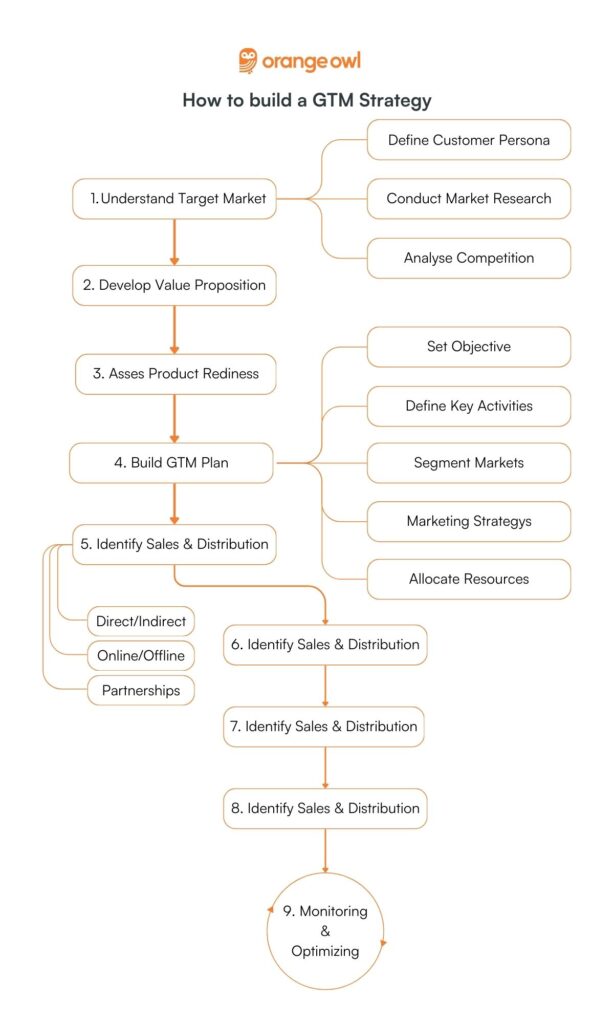
Here are essential components and steps to help you create a go-to-market strategy.
1. Understand your target market and build buyer personas
The harsh truth is that not everyone is your customer. Even if your product is the need of the hour or used by every business around the globe, everyone will still not be your customer. So, what you need to do is identify who your target audience is.
82% of marketers say having high-quality data on the target audience is important to succeed.
– Hubspot
Here’s what you can do:
- Define your customer personas: Create detailed profiles of your ideal customers, known as buyer personas. These should include demographic information (like age, gender, and income), as well as psychographic details (such as interests, values, and challenges). This helps you visualize who you’re targeting and understand their needs and behaviors.
- Conduct market research: Use both primary and secondary research to gather insights about your target market. Surveys, interviews, and focus groups can provide first-hand information about your customers’ preferences and pain points. Secondary research, including industry reports and competitive analysis, offers broader market trends and insights.
- Analyze your competitors: Understanding who your competitors are targeting and how they position themselves in the market can offer valuable clues about your own target market. Analyze their marketing tactics, customer reviews, and product offerings to identify gaps and opportunities.
2. Develop your value proposition
Unless you have something new or different to offer, getting the attention of your target audience can be a challenge. This is where developing your value proposition comes in as it differentiates your product or service in the market. It succinctly describes why customers should choose your offering over competitors’ by highlighting unique benefits and solving specific customer pain points.
From the previous stage, you’ll already have an understanding of your target audiences’ needs and pain points. You must have also created buyer personas. Now, you can leverage this data to craft unique and compelling messages for your audience. You can describe the positive impact your product or service will have on customers’ lives or businesses. Whether it’s saving time, reducing costs, improving performance, or enhancing quality of life, make the outcome clear and compelling.
However, here are some things to keep in mind while developing your value proposition:
- Keep your message concise and easy to understand.
- Validate with evidence to add credibility.
- Test and refine through surveys, interviews, or A/B testing.
3. Assess your product/service readiness and positioning
Before you start advertising your product, you want to ensure that you are 100% ready. This means being fully prepared to meet market demands and positioning your product effectively against the competitors.
- Ensure your product or service has all the necessary features to meet your target customers’ needs and expectations.
- Conduct thorough testing to ensure your product or service is reliable, stable, and free from defects.
- Evaluate the user experience to ensure it’s intuitive, user-friendly, and aligned with customer expectations.
- Prepare support resources, such as FAQs, user manuals, and customer service channels.
- Determine a pricing strategy that reflects the value of your offering, considers market standards, and aligns with your target customers’ willingness to pay.
4. Build your go-to-market plan
This is where you actually plan to enter the market. It requires outlining specific actions, timelines, and resources required to successfully introduce your product or service to the market.
- Set clear objectives: Establish clear, measurable objectives related to market entry, sales targets, customer acquisition, and brand awareness.
- Define key activities: Outline the key activities needed to achieve your objectives. This includes product launches, marketing campaigns, sales strategies, and customer support initiatives.
- Segment your market: Based on your understanding of the target market, segment your audience into smaller, manageable groups. Tailor your marketing and sales efforts to address the specific needs and preferences of each segment.
- Outline your marketing strategy: Develop a detailed marketing plan that outlines how you will attract and engage your target audience. This should include tactics like content marketing, social media, email campaigns, and advertising.
- Detail the sales strategy: Describe how you will sell your product or service, including sales channels, pricing strategy, and sales processes.
- Allocate resources: Identify the resources (financial, human, and technological) required to execute your plan.
5. Identify your sales and distribution channels
At this stage, you need to determine the most effective ways to sell and deliver your product or service to your customers. Based on your customer analysis, you will know the buying journey and preferences of your customers. This will help you choose sales channels that align with your customers’ habits. Here are some sales strategies that you’ll need to analyze:
- Direct vs. indirect channels: Consider the pros and cons of selling directly to customers (through your website, a sales team, etc.) versus using intermediaries (such as retailers, distributors, or partners). Direct channels give you more control over the customer experience, while indirect channels can expand your reach and reduce costs.
- Online and offline sales: In today’s market, a blend of online and offline channels often works best. Online channels might include e-commerce platforms, social media, and email marketing, while offline channels could involve physical retail, events, and direct sales teams. The right mix depends on where your customers are most likely to engage with your brand.
- Partnerships: Partnerships with other businesses can provide access to new markets and customers. Look for potential partners whose offerings complement yours and whose customer base overlaps with your target audience.
6. Finalize your marketing and promotional strategies
You need to effectively communicate the value of your product or service to your target audience and encourage them to take action. For this, you need to develop a comprehensive plan that covers how you will attract, engage, and convert your audience through various marketing and promotional tactics.
- Select your marketing mix: Choose the right mix of marketing channels to reach your audience. This includes digital marketing (SEO, PPC, social media, email marketing), content marketing (blogs, videos, ebooks), PR, events, and traditional advertising.
- Plan promotional activities: Determine any promotional activities or offers that can incentivize early adoption and purchases. This might include discounts, free trials, limited-time offers, or loyalty programs.
- Develop a content strategy: Create a content calendar that outlines what content you will produce, when it will be released, and through which channels. Ensure your content supports your marketing goals and speaks to your audience’s interests and needs.
- Allocate a budget: Distribute your marketing budget across chosen channels and tactics based on their potential impact and cost-effectiveness. Be prepared to adjust your budget allocation based on performance.
Check out the Top B2B GTM Agencies in India
7. Implement customer acquisition and onboarding plans
Effective customer acquisition and onboarding plans ensure you attract new customers and they transition to becoming proficient users of your product or service.
For acquisition:
- Identify the most effective channels to reach and engage your target audience,
- Craft tailored marketing campaigns and pricing strategies,
- And set clear goals to measure success (number of new customers or conversion rates).
For onboarding:
- Define what success looks like for new customers,
- Create onboarding materials (tutorials, FAQs, and how-to videos, etc.),
- Implement strategies to keep new customers engaged,
- And collect customer feedback.
8. Measure and optimize your performance
This is the final stage where you assess the effectiveness of your initiatives, and make necessary adjustments for continuous improvement and scale your GTM strategy. This process involves tracking key performance indicators (KPIs) against your objectives, analyzing the data, and refining your strategies based on insights gained.
- Determine metrics that best indicate the success of your GTM efforts. These could include sales figures, market share, customer acquisition costs, conversion rates, customer satisfaction scores, and retention rates, among others.
- Set up tracking tools to collect data on these metrics. This could involve analytics platforms, CRM software, and other tracking technologies that provide real-time data on how your GTM strategy is performing.
- Analyze data to understand the underlying factors driving your performance. Look for trends, patterns, and anomalies that can inform your understanding of what’s working and what’s not.
- Make informed adjustments to identify areas of your GTM strategy that need refinement. This might involve tweaking your marketing message, adjusting your target audience, shifting resources between channels, or modifying your product offering.
- Test and learn via A/B testing or other experimental approaches to compare outcomes and determine the most effective strategies.
- Foster a culture of continuous improvement to view the optimization process as ongoing, rather than a one-time effort.
GTM vs. Marketing Strategy vs. Marketing Plan
Using these terms interchangeably isn’t correct. This table will help you understand the differences between GTM vs. Marketing Strategy vs. Marketing Plan.
| Go-to-market strategy | Marketing strategy | Marketing plan | |
| Purpose | Outlines how to launch new products or enter new markets. | Defines how to achieve business goals through marketing efforts. | Details the specific actions, timelines, and resources to implement the marketing strategy. |
| Scope | Broad, covering product launch, target audience, pricing, distribution, and sales channels. | Focused on overall approach to reaching target audiences and competitive positioning. | Narrow, concentrating on specific marketing campaigns, channels, and tactics. |
| Time frame | Often project-based, centered around the timeline of a product launch or market entry. | Long-term, setting the direction for marketing efforts over a period of years or the product lifecycle. | Short-term to medium-term, usually covering a fiscal year or campaign period. |
| Key components | Product-market fit, value proposition, target market, distribution channels, sales strategy. | Target market, competitive advantage, positioning, brand messaging. | Marketing channels, budget allocation, KPIs, campaign schedules, content strategy. |
| Objective | To successfully introduce a product or service to the market and achieve initial market traction. | To establish a sustainable competitive advantage and engage effectively with the target market. | To execute the marketing strategy through specific, actionable initiatives that drive towards set goals. |
What are the Common Myths around B2B GTM?
Understanding common misconceptions in B2B GTM strategies is essential for developing effective marketing approaches. Many believe that a great product sells itself, or that a single strategy fits all, but these myths can derail success. It’s crucial to recognize that immediate results are rare, lower prices don’t always win, and more features don’t necessarily make a better product.
Additionally, B2B strategies differ significantly from B2C, and the product launch is just the beginning of ongoing efforts. Viral marketing isn’t essential, and more traffic doesn’t equate to success.
Finally, while higher customer acquisition costs might be justified for some B2B products, it’s vital to balance these costs with long-term profitability. By debunking these myths, businesses can tailor their GTM strategies to meet unique market conditions and customer needs, ensuring a more successful market entry and growth.
What are the Common Pitfalls around B2B GTM Strategies?
Developing a successful Go-To-Market (GTM) strategy is essential for B2B companies launching new products or services. However, common pitfalls such as lack of clear objectives, inadequate market research, and ignoring customer feedback can derail efforts.
Other mistakes include poorly defined value propositions, ineffective positioning, flawed pricing strategies, inconsistent messaging, neglecting sales enablement, underestimating digital marketing, and ignoring scalability.
By understanding and addressing these GTM pitfalls, businesses can enhance their GTM strategies and achieve better market success.
Takeaway
Crafting a go-to-market strategy for B2B companies is both an art and a science, requiring meticulous planning, execution, and ongoing optimization. This comprehensive guide aims to equip you with the knowledge and tools necessary to navigate the complex B2B landscape successfully.
Read a sample GTM case study here.
Remember, the key to a successful GTM strategy lies in deeply understanding your market, continuously refining your approach based on real-world feedback, and maintaining alignment across your organization. By prioritizing these strategic elements, your B2B company can achieve sustainable growth, build lasting customer relationships, and stand out in a competitive market.
Also, don’t miss out on the latest B2B GTM Trends and Stats.
FAQs on B2B Go-To-Market Strategies
The two main go-to-market (GTM) plan methodologies are the Funnel and Flywheel approaches. The Funnel methodology guides customers through a linear journey from awareness to purchase, while the Flywheel model emphasizes creating a self-sustaining cycle of engagement that leverages customer satisfaction to drive referrals and repeat business.
Go-to-market (GTM) strategies are used by businesses of all sizes across various industries, from startups launching their first product to established companies entering new markets or introducing new products. GTM strategies are essential for aligning product, marketing, sales, and customer success teams toward a successful market launch or expansion.
Customer relationship management (CRM) platforms like Salesforce, marketing automation tools such as HubSpot, analytics tools like Google Analytics, project management software such as Asana or Trello, and communication tools like Slack can support your GTM strategy creation and implementation process. These GTM tools help in managing customer data, automating marketing efforts, tracking performance, organizing tasks, and facilitating team collaboration.
The GTM strategy framework includes:
- Product-market fit: What needs of your target market does your product or service solve?
- Target audience: Who is experiencing the problems that your product or service solves?
- Competition and demand: Are there other businesses offering the same product or service as you?
- Distribution: How are you going to sell your product or service?
These four points are integral parts of the step-by-step go-to-market strategy and having answers to them will bring you closer to success.
- Underestimating the competition: Failing to accurately assess competitors’ strengths and strategies can leave you vulnerable to unexpected challenges in the market.
- Lack of alignment within the organization: Misalignment among departments on the GTM strategy can create internal confusion and dilute your market impact.
- Undefined target audience: Without a clear target audience, your marketing efforts can scatter, failing to connect deeply with any particular group.


